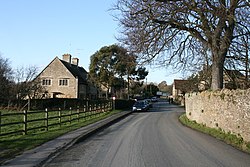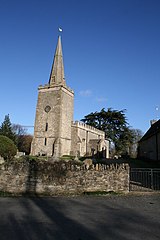Difference between revisions of "Shellingford"
m (→Parish church) |
|||
| Line 31: | Line 31: | ||
The parish church is dedicated to Saint Faith. It has a late-12th-century Norman nave and chancel.<ref name=Page/> The church has been much altered in succeeding centuries but retains its Norman chancel arch, south door, priest's door and part of the north door.<ref name=Pevsner>Pevsner, 1966, page 214</ref> The west tower is an Early English Gothic<ref name=Pevsner/> addition from the early part of the 13th century.<ref name=Page/> In the 14th century<ref name=Page/> the chancel was rebuilt with Decorated Gothic windows<ref name=Pevsner/> and a Decorated window was inserted in the south wall of the nave. In about 1400 a chapel was added to the north side of the chancel, but it does not survive.<ref name=Page/> The tower arch was rebuilt in the 15th century.<ref name=Page/> Early in the 16th century<ref name=Page/> two four-light Perpendicular Gothic windows<ref name=Pevsner/> were inserted in the south wall of the nave and another Perpendicular window was inserted in the north wall of the chancel.<ref name=Pevsner/> | The parish church is dedicated to Saint Faith. It has a late-12th-century Norman nave and chancel.<ref name=Page/> The church has been much altered in succeeding centuries but retains its Norman chancel arch, south door, priest's door and part of the north door.<ref name=Pevsner>Pevsner, 1966, page 214</ref> The west tower is an Early English Gothic<ref name=Pevsner/> addition from the early part of the 13th century.<ref name=Page/> In the 14th century<ref name=Page/> the chancel was rebuilt with Decorated Gothic windows<ref name=Pevsner/> and a Decorated window was inserted in the south wall of the nave. In about 1400 a chapel was added to the north side of the chancel, but it does not survive.<ref name=Page/> The tower arch was rebuilt in the 15th century.<ref name=Page/> Early in the 16th century<ref name=Page/> two four-light Perpendicular Gothic windows<ref name=Pevsner/> were inserted in the south wall of the nave and another Perpendicular window was inserted in the north wall of the chancel.<ref name=Pevsner/> | ||
| − | The spire was added in 1625 and three windows in the north wall of the nave were probably added at the same time.<ref name=Page/> The spire was destroyed by lightning in 1848<ref name=Page/> and rebuilt in 1852.<ref name=Pevsner/> The church contains a number of monuments, including one to William, 2nd Viscount Ashbrook (1767-1802) by John Flaxman.<ref name=Pevsner/> St | + | The spire was added in 1625 and three windows in the north wall of the nave were probably added at the same time.<ref name=Page/> The spire was destroyed by lightning in 1848<ref name=Page/> and rebuilt in 1852.<ref name=Pevsner/> The church contains a number of monuments, including one to William, 2nd Viscount Ashbrook (1767-1802) by John Flaxman.<ref name=Pevsner/> St Faith's is a Grade-I listed building.<ref>[http://www.imagesofengland.org.uk/Details/Default.aspx?id=251032&mode=quick Images of England website]</ref> |
| − | The tower seems to have had a ring of four bells by the early part of the 20th century.<ref name=Page/> The tenor bore the date 1586 but the founder was unidentified.<ref name=Page/> Edward Neale of Burford<ref name=DoveFounders>{{cite web |url=http://dove.cccbr.org.uk/founders.php |title=Bell Founders |author=|date=|work=Dove's Guide for Church Bell Ringers |publisher=|accessdate=17 January 2011}}</ref> cast the treble in 1653.<ref name=Page/> Another bell bore no date<ref name=Page/> but may have been cast in about 1599.<ref name=DoveDetails>{{cite web |url=http://dove.cccbr.org.uk/detail.php?searchString=Shellingford&numPerPage=10&Submit=Go&searchAmount=%3D&searchMetric=cwt&sortBy=Place&sortDir=Asc&DoveID=SHELLINGFO |title=Shellingford S Faith |author=|date=|work=Dove's Guide for Church Bell Ringers |publisher=|accessdate=17 January 2011}}</ref> Henry Bagley III, who had foundries at [[Chacombe]] and [[Witney]],<ref name=DoveFounders/> cast the final bell of the four in 1738.<ref name=Page/> There is also a Sanctus bell that was cast in 1663.<ref name=DoveDetails/> In the 20th century the ring was increased to six, but of the original bells only the Bagley and undated bells survive.<ref name=DoveDetails/> Mears & Stainbank of the Whitechapel Bell Foundry cast the current tenor in 1920.<ref name=DoveDetails/> In 1998 Whitechapel Bell Foundry cast the present treble and another bell.<ref name=DoveDetails/> There is also another bell from the Whitechapel foundry, cast by Thomas Mears | + | The tower seems to have had a ring of four bells by the early part of the 20th century.<ref name=Page/> The tenor bore the date 1586 but the founder was unidentified.<ref name=Page/> Edward Neale of Burford<ref name=DoveFounders>{{cite web |url=http://dove.cccbr.org.uk/founders.php |title=Bell Founders |author=|date=|work=Dove's Guide for Church Bell Ringers |publisher=|accessdate=17 January 2011}}</ref> cast the treble in 1653.<ref name=Page/> Another bell bore no date<ref name=Page/> but may have been cast in about 1599.<ref name=DoveDetails>{{cite web |url=http://dove.cccbr.org.uk/detail.php?searchString=Shellingford&numPerPage=10&Submit=Go&searchAmount=%3D&searchMetric=cwt&sortBy=Place&sortDir=Asc&DoveID=SHELLINGFO |title=Shellingford S Faith |author=|date=|work=Dove's Guide for Church Bell Ringers |publisher=|accessdate=17 January 2011}}</ref> Henry Bagley III, who had foundries at [[Chacombe]] and [[Witney]],<ref name=DoveFounders/> cast the final bell of the four in 1738.<ref name=Page/> There is also a Sanctus bell that was cast in 1663.<ref name=DoveDetails/> In the 20th century the ring was increased to six, but of the original bells only the Bagley and undated bells survive.<ref name=DoveDetails/> Mears & Stainbank of the Whitechapel Bell Foundry cast the current tenor in 1920.<ref name=DoveDetails/> In 1998 Whitechapel Bell Foundry cast the present treble and another bell.<ref name=DoveDetails/> There is also another bell from the Whitechapel foundry, cast by Thomas Mears II in 1841.<ref name=DoveDetails/> |
St Faith's is now part of the [[Uffington]] Benefice, along with the parishes of [[Baulking]] and [[Woolstone, Berkshire|Woolstone]]. | St Faith's is now part of the [[Uffington]] Benefice, along with the parishes of [[Baulking]] and [[Woolstone, Berkshire|Woolstone]]. | ||
Latest revision as of 14:52, 8 October 2023
| Shellingford | |
| Berkshire | |
|---|---|
 Shellingford | |
| Location | |
| Grid reference: | SU3193 |
| Location: | 51°38’24"N, 1°32’31"W |
| Data | |
| Population: | 157 (2001) |
| Postcode: | SN7 |
| Dialling code: | 01367 |
| Local Government | |
| Council: | Vale of White Horse |
| Parliamentary constituency: |
Wantage |
Shellingford, historically also spelt Shillingford is a village in northern Berkshire, found a mile to the west of Stanford in the Vale, to which it is linked by a quiet footpath, and some 2½ miles south-east of Faringdon.
Name of the village
In the 10th century the name of the village is found written Scaringaford and in the Domesday Book of 1086 its entry calls it Serengeford.[1] 13th century forms of the name included Salingeford, Schalingeford, Shallingford, Sallingford and Schillingford.[1] In the 18th century it was recorded as Shillingworth.[1] The spelling "Shillingford" is now very rare, which avoids confusion with the village of Shillingford, fifteen miles away in Oxfordshire.
History
Abingdon Abbey held the manor of Shellingford from 931 until the dissolution of the monasteries in 1538.[1] In 1598, the courtier Sir Henry Neville bought the manor.[1] It was later held by the Packer family.[1] In 1738 Sarah Churchill, Duchess of Marlborough bought it as an investment.[1] It was later held by the Goodlake and Ashbrook families.[1]
In the 19th century the Goodlakes built a new house to the north of the village, Kitemore House, to replace the Elizabethan manor house south of the church, which was then demolished.[1]
Between 1931 and 1957 there was an aerodrome, RAF Shellingford, between Shellingford and Stanford in the Vale. A quarry now occupies part of the site.
Parish church
The parish church is dedicated to Saint Faith. It has a late-12th-century Norman nave and chancel.[1] The church has been much altered in succeeding centuries but retains its Norman chancel arch, south door, priest's door and part of the north door.[2] The west tower is an Early English Gothic[2] addition from the early part of the 13th century.[1] In the 14th century[1] the chancel was rebuilt with Decorated Gothic windows[2] and a Decorated window was inserted in the south wall of the nave. In about 1400 a chapel was added to the north side of the chancel, but it does not survive.[1] The tower arch was rebuilt in the 15th century.[1] Early in the 16th century[1] two four-light Perpendicular Gothic windows[2] were inserted in the south wall of the nave and another Perpendicular window was inserted in the north wall of the chancel.[2]
The spire was added in 1625 and three windows in the north wall of the nave were probably added at the same time.[1] The spire was destroyed by lightning in 1848[1] and rebuilt in 1852.[2] The church contains a number of monuments, including one to William, 2nd Viscount Ashbrook (1767-1802) by John Flaxman.[2] St Faith's is a Grade-I listed building.[3]
The tower seems to have had a ring of four bells by the early part of the 20th century.[1] The tenor bore the date 1586 but the founder was unidentified.[1] Edward Neale of Burford[4] cast the treble in 1653.[1] Another bell bore no date[1] but may have been cast in about 1599.[5] Henry Bagley III, who had foundries at Chacombe and Witney,[4] cast the final bell of the four in 1738.[1] There is also a Sanctus bell that was cast in 1663.[5] In the 20th century the ring was increased to six, but of the original bells only the Bagley and undated bells survive.[5] Mears & Stainbank of the Whitechapel Bell Foundry cast the current tenor in 1920.[5] In 1998 Whitechapel Bell Foundry cast the present treble and another bell.[5] There is also another bell from the Whitechapel foundry, cast by Thomas Mears II in 1841.[5]
St Faith's is now part of the Uffington Benefice, along with the parishes of Baulking and Woolstone.
References
- ↑ 1.00 1.01 1.02 1.03 1.04 1.05 1.06 1.07 1.08 1.09 1.10 1.11 1.12 1.13 1.14 1.15 1.16 1.17 1.18 1.19 1.20 1.21 Page & Ditchfield, 1924, pages 475-478
- ↑ 2.0 2.1 2.2 2.3 2.4 2.5 2.6 Pevsner, 1966, page 214
- ↑ Images of England website
- ↑ 4.0 4.1 "Bell Founders". Dove's Guide for Church Bell Ringers. http://dove.cccbr.org.uk/founders.php. Retrieved 17 January 2011.
- ↑ 5.0 5.1 5.2 5.3 5.4 5.5 "Shellingford S Faith". Dove's Guide for Church Bell Ringers. http://dove.cccbr.org.uk/detail.php?searchString=Shellingford&numPerPage=10&Submit=Go&searchAmount=%3D&searchMetric=cwt&sortBy=Place&sortDir=Asc&DoveID=SHELLINGFO. Retrieved 17 January 2011.
Sources
- Page, W.H.; Ditchfield, P.H., eds (1924). A History of the County of Berkshire, Volume 4. Victoria County History. pp. 475–478.
- Pevsner, Nikolaus (1966). Berkshire. The Buildings of England. Harmondsworth: Penguin Books. pp. 214–215.
Outside links
| ("Wikimedia Commons" has material about Shellingford) |

